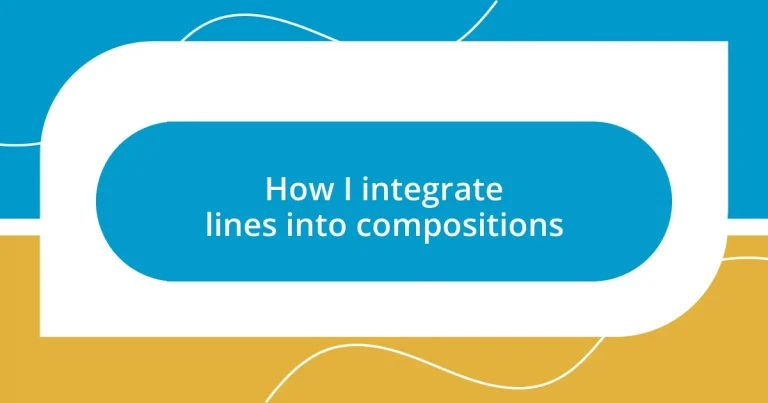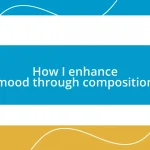Key takeaways:
- Lines are essential in compositions, influencing structure, movement, and emotional response; different line types can evoke specific feelings.
- Techniques like varying line weight, overlapping lines, and using directional guides enhance depth, complexity, and storytelling in artwork.
- Analyzing famous compositions reveals how artists use lines to create balance and convey emotions, inspiring personal artistic exploration.
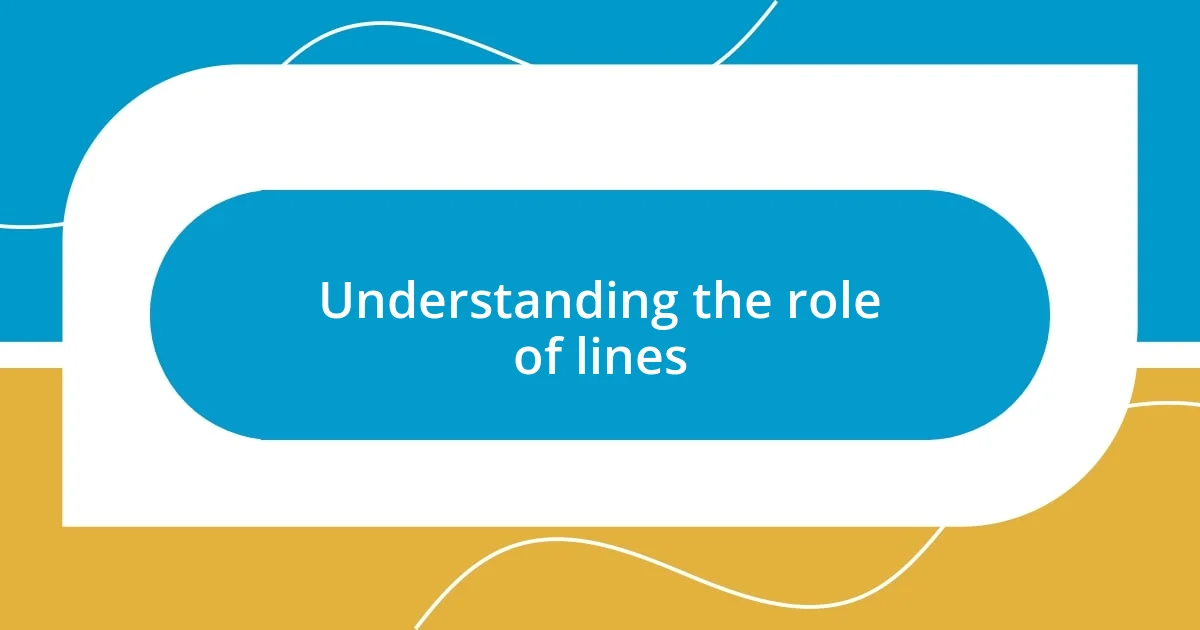
Understanding the role of lines
Lines serve as the backbone of any composition, providing structure and guiding the viewer’s eye throughout the artwork. When I’m creating a piece, I often think about how lines can convey movement or emotion—like the gentle curve of a landscape that can evoke a sense of calm. Have you ever noticed how a jagged line can create tension or excitement? The choice of line quality is essential; it can dramatically alter the mood of your work.
I recall a project where I was experimenting with contours and outlines. I realized that the way I integrated lines transformed not just the shapes but also the feelings each piece emitted. For instance, using soft, flowing lines gave a sense of serenity, while sharp, angular lines energized the composition. This was a revelation for me; it underscored how intentional line use isn’t just about aesthetics—it communicates.
It’s fascinating how different cultures interpret lines. In one of my discussions with fellow artists, we explored how certain line styles can express cultural values. I remember a striking moment when a friend from Japan illustrated the concept of “iki,” explaining how delicate lines reflect elegance in their art forms. This gave me pause to think about my own work—what stories are the lines in my compositions telling? This understanding deepens not just my art, but also my connection to different perspectives and experiences.
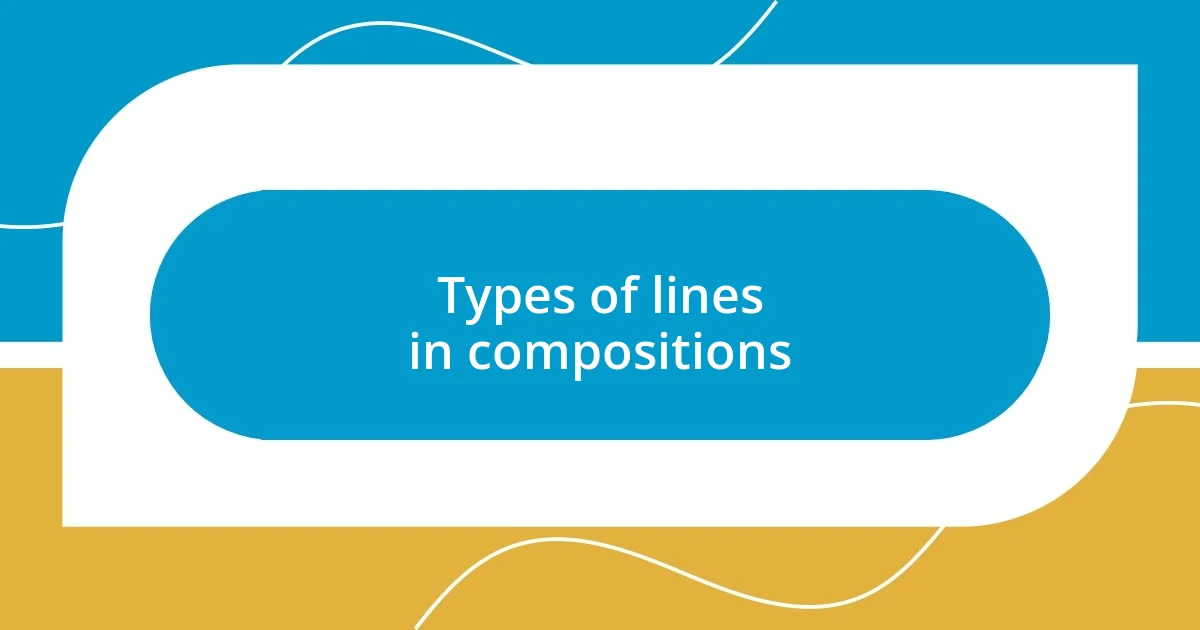
Types of lines in compositions
When I think about the types of lines in compositions, I can’t help but reflect on my own experiences experimenting with various line styles. Straight lines often evoke a sense of order and stability, while curved lines can introduce fluidity and grace. There’s this one time I was working on an abstract piece, and I found that adding a series of diagonal lines injected dynamism and energy, giving the work a lively twist that surprised even me.
Here’s a quick overview of different line types and their potential emotional impacts:
- Straight Lines: Convey strength and reliability, often setting a formal tone.
- Curved Lines: Represent softness and movement, creating a feeling of serenity.
- Jagged Lines: Impart chaos or tension, effectively energizing a composition.
- Diagonal Lines: Suggest action and excitement, drawing the eye across the piece.
- Dotted or Dashed Lines: Indicate playfulness or spontaneity, making the composition feel light and fun.
Each type holds its own unique power to elicit specific feelings, shaping the narrative of the artwork in ways I often enjoy exploring.
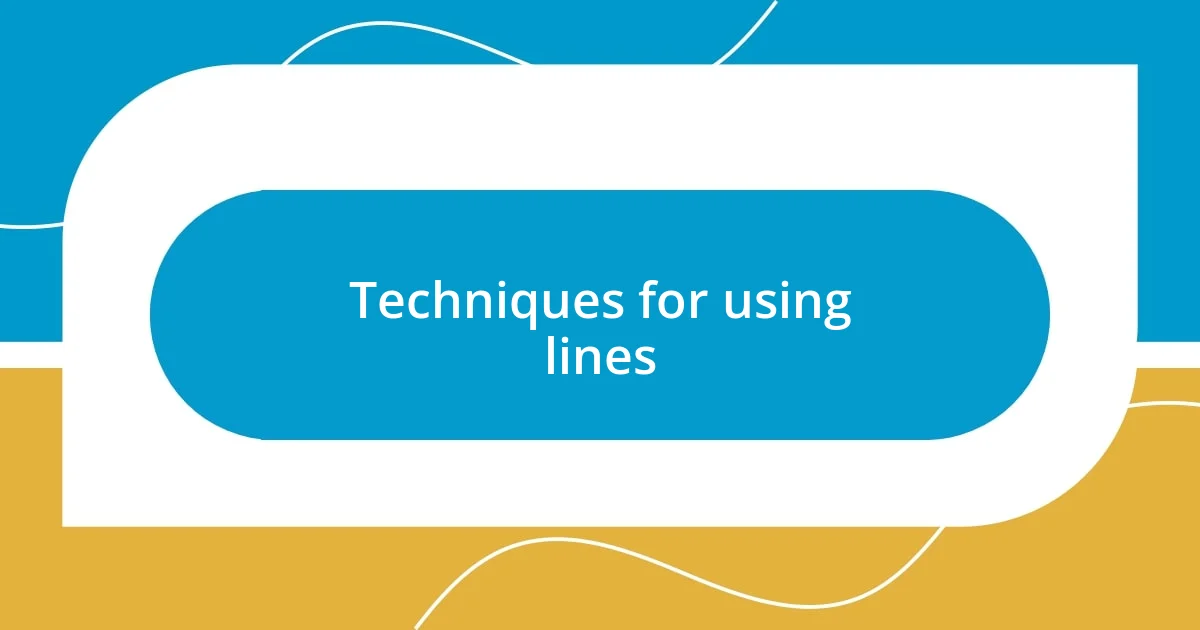
Techniques for using lines
When integrating lines into my compositions, I find that varying line weight can significantly change the overall impact. For instance, thick lines often ground the viewer’s attention, while thinner lines can create a sense of delicacy and vulnerability. I remember a time when I used a bold outline for a character in a graphic novel I was working on, which separated them from the background and made them feel more prominent—almost larger than life. This balancing act of line weight can drive engagement with the piece.
Another technique I frequently explore is the use of overlapping lines to create depth and complexity. In one of my pieces focused on urban landscapes, I layered lines to build sharp contrasts and highlighted areas, inviting viewers to engage more deeply. It’s interesting how those overlapping lines not only suggest physical space but can also represent various emotional layers of the narrative. This modulation of interaction through line integration often draws me into a deeper exploratory conversation with my own work.
Using lines as directional guides is something I am passionate about. I’ve found that lines can lead the viewer’s eye to focal points in a piece. Once, during a workshop, I manipulated lines to create an invisible path that guided viewers through a narrative arc, enhancing their emotional journey through the artwork. It reinforced my belief that lines are more than just aesthetic choices; they are powerful tools for storytelling.
| Technique | Description |
|---|---|
| Varying Line Weight | Using thick and thin lines to create emphasis and emotional depth. |
| Overlapping Lines | Layering lines to build complexity and add depth to compositions. |
| Directional Lines | Guiding the viewer’s eye and enhancing storytelling through strategic line placement. |
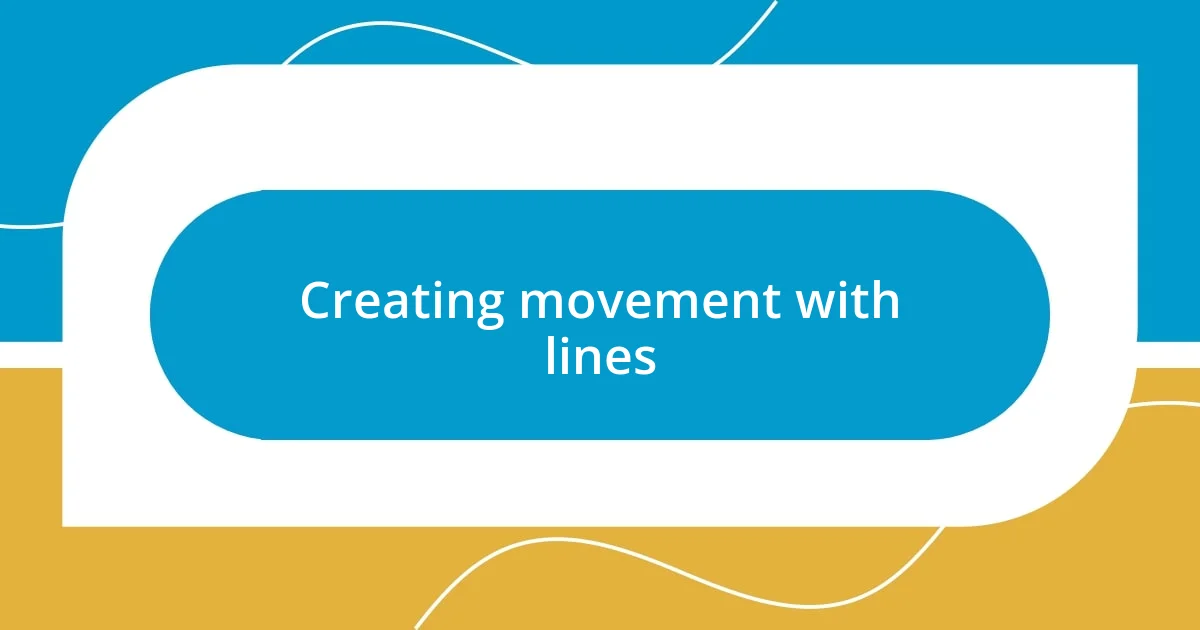
Creating movement with lines
Creating movement with lines can completely transform a composition, drawing the viewer’s eye in unexpected directions. When I added swirling lines to a piece inspired by a stormy ocean, I was amazed at how they seemed to capture the essence of turbulence. Have you ever noticed how your eyes travel along the curves, mimicking the movement of water? It’s as if the lines invite you to experience the chaos, making you feel part of the scene rather than just an observer.
In another project, I explored the use of diagonal lines interwoven with gradual curves to suggest a sense of race and urgency. Watching viewers’ reactions, I found that these lines not only created movement but also evoked emotions like anticipation and thrill. Imagine standing in front of a painting, feeling your heart quicken as you follow those lines — it’s the magic of movement that resonates on a deeper level, one that connects you emotionally to the artwork.
Conversely, I sometimes employ subtle lines to establish a more serene flow, like gentle hills leading the eye outward in a landscape piece. This technique serves to guide viewers softly, allowing them to absorb the beauty without feeling rushed. I always ask myself, how can I make this path feel welcoming? It’s fascinating how lines can shift from a gentle nudge to an assertive push, shaping the viewer’s experience and emotional journey through the artwork.
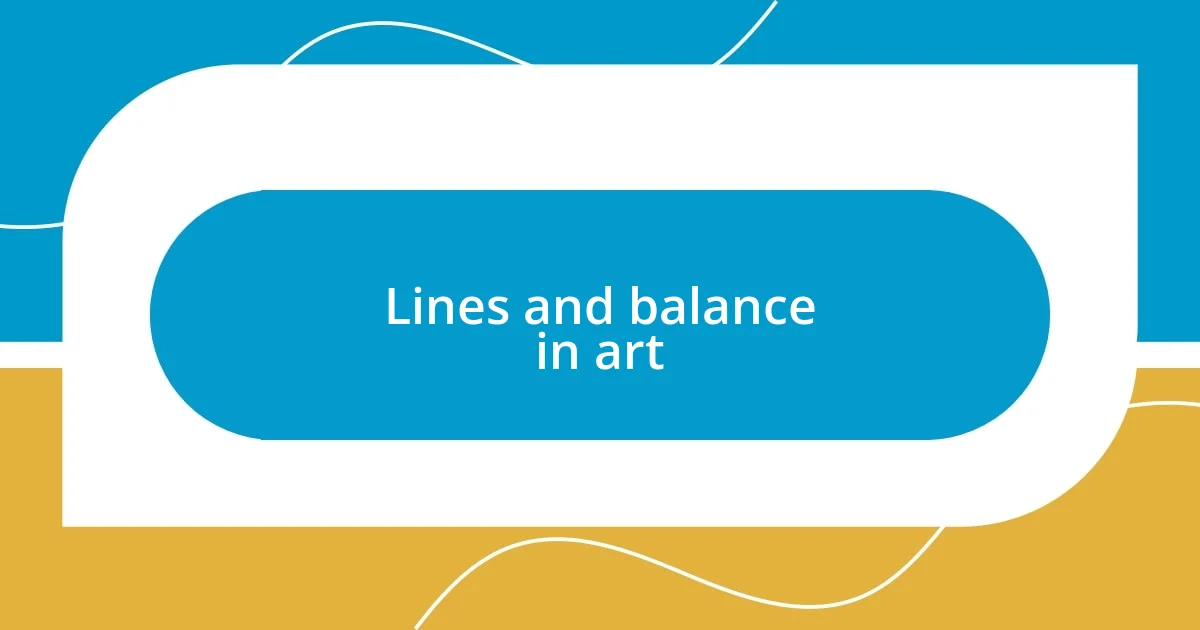
Lines and balance in art
When I think about lines and balance in art, I can’t help but reflect on how they dictate the harmony within a composition. I recall a vibrant piece I created where every line not only served a visual purpose but also contributed to an emotional equilibrium. For instance, a strong horizontal line at the base offered stability, while curvilinear lines above created a sense of movement, reminding me of the delicate dance between chaos and serenity.
I often find myself experimenting with different line arrangements to achieve a balanced feel. In one of my mixed media projects, I played with asymmetry by placing vibrant diagonal lines on one side while grounding them with heavier, more solid lines on the opposite side. It was a revelation to see how that slight imbalance breathed life into the piece, challenging the viewer’s expectation and fostering a dynamic visual experience.
Sometimes, I stop to wonder: how do lines interact with the viewer’s emotions? I’ve noticed that in a piece with harmonious, flowing lines, people tend to linger longer, absorbed in its calmness. Conversely, jagged or erratic lines can provoke a sense of unease, evoking feelings of tension. This interplay between line and emotional response makes me eager to explore further, as I believe the right balance can create an unforgettable connection between the artwork and its audience.

Practical exercises for integration
Practical exercises can truly enhance how I integrate lines into my compositions. One exercise I like to do is to create quick sketches using only lines. This practice helps me explore different line types—think thick, thin, straight, and curved—without overthinking the subject matter. It’s liberating to see how these simple strokes interact and form unexpected shapes, almost like a line dance across the paper. Have you ever tried it? You might be surprised at how much energy and rhythm you can evoke in mere minutes.
Another enriching technique I use involves compiling visual references of artworks that resonate with me for their use of lines. I then analyze how each artist employs lines to guide the viewer’s eye. Recently, I studied a piece that featured a chaotic array of jagged lines that drew me in, sparking a realization: the artist harnessed tension through sharpness. Engaging with artworks like these fuels my creativity and often prompts me to experiment with line orientations in my own projects, pushing the boundaries of my artistic voice.
Finally, sometimes I challenge myself by collaborating with a fellow artist to create a piece side by side. We alternate adding lines to the canvas without discussing our intentions. This unpredictable exchange often leads to beautiful discoveries. As our lines intertwine, I find myself considering, “How can this element enhance balance or movement?” The contrasting intentions create a dynamic dialogue within the composition, and it’s always thrilling to see how our artistic energies merge. Have you ever worked with someone else on a piece? It can be a fantastic way to break out of your comfort zone and ignite new ideas.
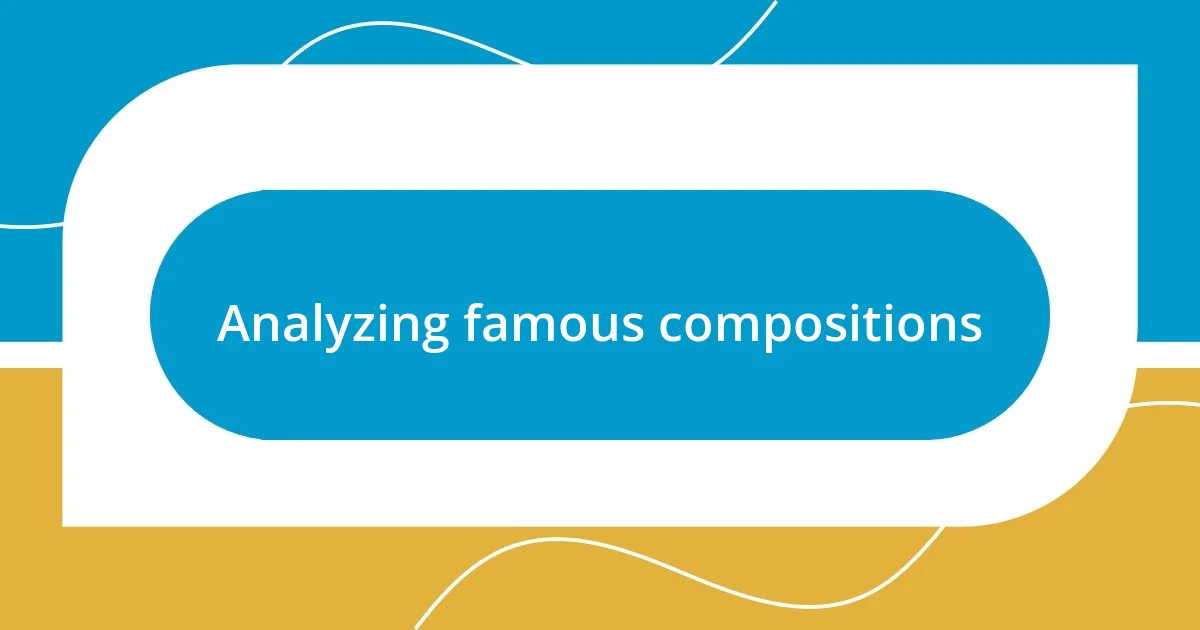
Analyzing famous compositions
Analyzing famous compositions reveals how master artists utilize lines to create balance and evoke feelings. Take Vincent van Gogh’s “Starry Night,” for instance. The swirling lines not only depict movement in the sky but also mirror the emotions of turbulence and wonder. As I observed this piece more closely, I felt a longing—a connection to the emotional depth captured by those curving strokes. Have you ever felt like the lines in a painting spoke louder than the colors themselves?
In examining Piet Mondrian’s work, it’s fascinating to see how he employed straight lines to create a sense of order amidst chaos. I remember standing in front of his famous “Composition with Red, Blue, and Yellow,” and realizing how those seemingly simple lines generated a geometric tension that felt both calming and invigorating. It made me ponder: how do such basic elements have the power to transform a space and our emotions within it?
I’ve also found that analyzing compositions from modern artists can be equally enlightening. For example, the bold, erratic lines of Jean-Michel Basquiat express raw energy and a sense of urgency. When I first encountered his work, I was struck by how those lines radiated a frenetic rhythm, almost pulling me into his world of thoughts and struggles. I wondered, as I reflected on it, how can chaos be so beautifully chaotic, guiding us on an emotional journey? This exploration into the intersection of lines and emotion in compositions continuously inspires my artistic practice.












